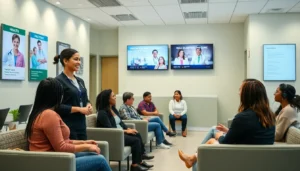In a world where instant gratification reigns supreme, the waitlist system might seem like a cruel joke. Picture this: you’re excitedly eyeing that new restaurant or hot concert, only to be met with a “please hold” message that feels more like a cosmic time-out. But fear not! Waitlists can be more than just a test of patience; they can be a game-changer in managing demand and enhancing customer experience.
Table of Contents
ToggleOverview of Waitlist Systems
Waitlist systems offer structured management for high-demand scenarios across various sectors. They organize customers in a queue, ensuring fairness while reducing chaos. Many restaurants and venues leverage these systems to enhance customer experience by providing estimated wait times.
Organizations often adopt digital waitlist solutions, which allow customers to join remotely. Such technology streamlines the process and keeps guests informed via notifications. Over recent years, many establishments have transitioned to app-based systems, enabling users to reserve spots conveniently.
Data suggests that effective waitlist management can increase customer satisfaction scores by up to 25%. This improvement stems from reduced perceived wait times and the ability to allocate resources efficiently. During peak hours, waitlists prevent overcrowding and improve the overall atmosphere in venues.
Staff benefits immensely from well-managed waitlists. They can focus on service quality instead of manually tracking customer flow. Simplified communication between staff and patrons further enhances the dining experience, allowing for smoother operations.
Insights reveal that consumers often appreciate transparency in waitlist procedures. Providing real-time updates makes guests feel informed, ultimately fostering loyalty. Frequent updates or estimated times can reduce frustration, making the wait feel shorter.
Implementing a waitlist system can transform the way businesses interact with their customers. With proper execution, it creates a win-win situation: customers receive timely services, and organizations enjoy optimized operations.
Key Features of Waitlist Systems
Waitlist systems offer innovative features that enhance customer management and streamline operations. Significant aspects include the registration process and notification mechanisms.
Registration Process
Customers can join a waitlist quickly and effortlessly. Most systems allow registrations via mobile apps or websites, making it convenient for users. Information such as names, party sizes, and expected arrival times is typically collected. This data helps businesses manage customer flow efficiently. After registration, patrons often receive confirmation messages, ensuring clarity. Such transparency fosters trust in the process. A well-designed registration interface increases user satisfaction and encourages repeat usage.
Notification Mechanisms
Notification mechanisms keep customers informed throughout their waiting experience. Many systems utilize SMS or app notifications to update patrons on their waitlist status. Alerts may include estimated wait times and seating readiness messages. Real-time updates help reduce anxiety and uncertainty among customers. Studies indicate that effective notifications can enhance customer satisfaction by approximately 25%. Such communication encourages loyalty and a positive perception of the business, while also allowing staff to concentrate on enhancing in-person service.
Benefits of Using Waitlist Systems
Waitlist systems enhance operations across various industries, providing significant advantages that impact both businesses and customers. These systems streamline processes, leading to improved overall performance and satisfaction.
Increased Efficiency
Efficiency improves as waitlist systems automate customer tracking. Businesses experience a reduction in manual tasks, allowing staff to concentrate on high-quality service. Streamlined operations lead to a more organized environment, which benefits both employees and patrons. Data shows that optimized waitlist management can improve customer flow by upwards of 25%. This reduction in chaos means that teams can allocate resources more effectively, ultimately leading to increased productivity and reduced wait times for customers.
Improved Customer Experience
Customer experience transforms significantly with the right waitlist system in place. Transparent processes foster trust, as patrons receive real-time updates about their wait status. Notifications via SMS or app alerts alleviate anxiety, helping customers feel valued and informed. Studies indicate that effective communication can raise customer satisfaction by approximately 25%. Furthermore, reducing perceived wait times enhances the overall feeling of enjoyment during visits. Engaging customers even before they arrive helps businesses build loyalty and repeat patronage.
Challenges and Limitations
Waitlist systems, while beneficial, encounter several challenges that affect their effectiveness and user experience. Understanding these limitations helps businesses implement more effective solutions.
Technical Issues
Technical problems can disrupt waitlist operations, causing significant inconveniences. System outages or software glitches may lead to inaccurate wait times or lost reservations. These disruptions frustrate both customers and staff. Operational inefficiencies emerge when tech issues prevent proper tracking of customers, undermining the potential benefits of streamlined processes. Studies indicate that up to 15% of users might abandon businesses during tech failures. Investing in reliable software and maintaining a proactive support system is crucial to minimizing technical difficulties.
User Engagement
User engagement plays a vital role in the success of waitlist systems. Lack of transparency can lead to misunderstandings and dissatisfaction among customers. When users don’t receive timely updates, they may feel frustrated and undervalued. Research shows customers are 25% more likely to return when they receive real-time notifications about their status. Engaging communication can foster loyalty. Personalized messages or quick check-ins can significantly enhance the customer experience, making users feel more connected to the service. Implementing feedback surveys can also encourage customers to voice their opinions, further enhancing engagement strategies.
The waitlist system proves to be a valuable asset in managing demand while enhancing customer satisfaction. By providing transparency and real-time updates, these systems not only streamline operations but also foster loyalty among patrons. Businesses that adopt effective waitlist solutions can significantly improve their service quality and overall efficiency.
While challenges exist, such as technical issues and the need for user engagement, understanding these aspects allows organizations to refine their approach. Ultimately, a well-implemented waitlist system can transform the customer experience, turning what once felt like a burden into a seamless and enjoyable process.



